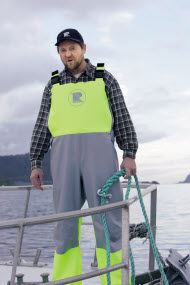
|
A fisherman who falls overboard wearing these trousers and their matching jacket will stay afloat. There are buoyancy pads in both the front and rear of the garment. |
If a fisherman falls into the sea, the new oilskin suit will keep him afloat - in fact, upright in the water, a position that will make it easier to climb on board again, or to be dragged on board by others.
The new suit sports large areas of fluorescent yellow. Both the colour and the built-in buoyancy will improve a fisherman’s chances of being found if he should fall into the sea.
Dangerous occupation
Between January 1988 and June 2005, 80 Norwegian fishermen died at sea, an average of 10 or 11 deaths a year. Either “shipwreck/sinking” or “falling overboard” were responsible for more than half of these deaths.
This was the background for the decision of a handful of Norwegian institutions to develop new clothing for fishermen. The new suit is the result of a cooperative effort involving SINTEF, the Norwegian Fishermen’s Association, the Gjensidige Insurance Company and the equipment manufacturer Regatta.
Comfort and design
The aim was to develop a suit that would both promote safety and actually be used. The project group therefore emphasised the importance of developing clothing that would be comfortable to work in. In the process, the members of the project adopted ideas that have already been applied in snowboarding clothing and life-jackets for canoeists. They also chose a design that actually appealed to the fishermen, according to the feedback they have received from users who have tested the suit.
Survey of user requirements
SINTEF started the development process by surveying what fishermen wanted and needed from their work clothing. This material was used as a basis for the design of the new oilskins.
The clothing project forms part of a wider effort on health, safety and the environment in the fishing fleet, and was financed by the Fishing and Aquaculture Industry Research Fund, the Gjensidige Insurance Company, Regatta AS and SINTEF.
Taking steps to prevent injuries
The Gjensidige Insurance Company joined the clothing project in the hope of being able to reduce the number of injuries that take place in the fishing sector.
In 2006, Gjensidige will distribute the new work clothes as part of its insurance packages for inshore and coastal fishermen. The package covers the crews of vessels of up to 27 metres in length who have a comprehensive insurance policy in the company through a cooperative agreement between Gjensidige and the Norwegian Fishermen’s Association.
Fishermen’s Association pleased
The new work suit, which has been given the name “Regatta Fisherman”, is unique in the world. The Norwegian Fishermen’s Association has great hopes for the clothing concept.
“We regard the development of this work suit as an important milestone in the process of preventing accidents, and I really hope that as many fishermen as possible will adopt it as soon as they can”, says Reidar Nilsen, chairman of the Norwegian Fishermen’s Association.
By Svein Tønseth
Contact:
{DynamicContent:Ansatt link}, SINTEF Health Research
